About the Parliamentary Record
The historical records of the Scottish parliament contain a wealth of information on various aspects of Scotland's past, from great matters of state involving political, social, economic and foreign policy, to more everyday concerns reflecting peculiarly local or domestic issues. This page attempts to give some idea of the breadth of topics which can be found within the records, as well as some suggested areas suitable for further research.
- What sort of information can I expect to find within the parliamentary record?
- Can RPS be of use in tracing my family history?
- I’m interested in researching the Scots language. What sort of material can I find in RPS?
- I’m investigating the history of my local area. Is there anything relevant to my research within the parliamentary record?
- What other issues did parliament deal with that I can investigate further?
1. What sort of information can I expect to find within the parliamentary record?
The online edition contains the proceedings of the pre-1707 Scottish parliament, one of Scotland’s most significant political bodies. The role of parliament in major historical events, such as religious reformation, political union or at times of war, is perhaps already familiar to those interested in Scotland’s past, but much of parliament’s business was more mundane and everyday. It was an institution that lay at the heart of the nation for nearly 500 years and one which was responsible for laws that impinged on each person’s daily life. Parliament legislated on matters as varied as the economy, education and transport to standards of dress and sporting pastimes. Thus the records are one of Scotland’s richest historical sources, containing information on a multitude of diverse themes, events and individuals.
Widely used by historians and scholars to provide an insight into the country’s past, the record also includes much information of interest to the non-specialist or general enquirer. The parallel translated version available through this site provides an accessible point of entry into the record absent from previous editions, with direct links back to the manuscript text for those interested in the original language and spelling. And since the online resource is entirely searchable by word or phrase it can be easily used, for example, by school pupils researching an essay, by family historians looking up surnames or tracing ancestors, and by local historians seeking to explore their community and the people who have lived within it. And these are just a few examples of what RPS can be used for.
2. Can RPS be of use in tracing my family history?
Yes, RPS is a valuable supplement to the traditional sources for genealogists, such as the registers of births, marriages and deaths, sasines and old parish records, since it contains information which predates these series. Most obviously there are details on individuals who held political office or sat as a member of parliament, but it is certainly possible to find references to a wide range of people within the record.
For instance, parliamentary ratifications (private acts where the monarch gifted lands or privileges to reward loyal subjects) can provide significant information on local landowners and their families, including the lines of descent and details on spouses and dependents who were subsequently to inherit. A good example is given in the 1592 ratification in favour of Thomas Boyd, lord Boyd, where the line of succession, from sons to brothers to cousins, is explicitly stated, neatly linking names and generations [1592/4/203]. Estates, houses and farms belonging to specific families can also be traced through such records, as occasionally can the name of tenants, servants and others who lived and worked on these lands.

1661 act promoting the establishment of soapworks
Occupations are frequently mentioned, with some individuals being granted privileges related to their particular trade. Those professions detailed within the manuscripts can range from the most ordinary, from weaving [1641/8/290], metal-casting [1686/4/60] and soap-making [1695/5/235], to the relatively obscure, such as the production of needles [1661/1/367], girdle-making in Culross [1669/10/96] and the manufacture of combs in Leith [1695/5/232].
Tax or supply records and lists of militia personnel and commissioners for war, found within the parliamentary record from the mid-seventeenth century onwards, provide a wealth of information on surnames and their particular geographical spread. See, for instance, the hundreds of names from all over Scotland contained in just one act [1644/6/225].
Signatories to petitions may provide a snapshot of the most prominent local families or individuals who were active in public life. Supplications to parliament can cover an extremely diverse range of themes, from lobbying for improvements to local infrastructure, such as the building of roads or bridges [A1696/9/4], to organised political campaigns, such as that in support of Scotland’s Panamanian colony of New Caledonia [A1700/10/25] or against incorporating union with England [1706/10/45]. Witnesses to warrants, processes and other legal documents that survive within the parliamentary record can also supply information on extended family networks, neighbours and clan associations, be it subscribers to an official public instrument [A1461/3] or to customary grants of land [A1476/7/2].
Some acts directly relate to genealogical issues, especially when parliamentary approval was sought for the alteration of a surname, relatively common as part of a marriage or adoption contract. See, for example, the 1581 act passed in favour of William Maxwell granting him the surname of Baillie and arms of the Lanarkshire house of Lamington [1581/10/65]; or the 1587 act where Harry Lindsay (later thirteenth earl of Crawford) assumed the Charteris surname of his adoptive parents [1587/7/145].
Disagreements with others could lead to the alteration of traditional designations, as their holders sought a fresh start under a new alias. Such an instance of unspecified ‘discontent’ in 1460 prompted one family to uproot from Annandale to Perthshire, assuming a new surname in the process. It was not until 1663 that parliamentary permission was sought by David Souter and his kinsmen to revert back to their ‘true and ancient’ title of Johnston [1663/6/43], with the assurance that any legal documents made under their assumed name would remain valid.
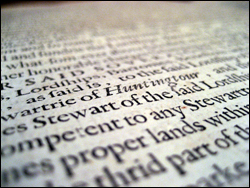
1600 act forfeiting the Place of Ruthven to
the crown
Particularly heinous crimes could lead to the total proscription of a particular surname, such as that of Ruthven, which was outlawed in 1600 after the family had been involved in numerous treason plots against the king. The ancient family seat, the Place of Ruthven, was seized as crown property and renamed Huntingtower in a further effort to eradicate all traces of the title [1600/11/11]. The name of the ‘wicked and rebellious clan of MacGregor’ was likewise outlawed in 1603, restored in 1661, but disallowed once more in 1693, preventing all holders from entering into any form of legal contract. The records document an instance of one petitioner, Evan MacGregor, seeking a review of the ban. In his own case he was successful, being granted leave to use the surname for the remainder of his life, but was ordered to choose another for his children and posterity, eventually settling on the derivative patronym ‘Evanson’ [1695/5/30].
Exceptionally detailed genealogies can also be found within the parliamentary record, such as that given in the bore-breive (birth certificate) granted in 1686 to Charles Edward Colbert, marquis of Seignelay, the son of the chief minister to Louis XIV of France. Seeking to claim Scottish roots to bolster his standing in French society, a lineal descendancy from St Cuthbert (d.687) is claimed, although particular details are limited to demonstrating a pedigree from the Highland family the Cuthberts of Castlehill [1686/4/65]. Another instance, spanning generations and continents, is an act of 1641 approving the ancestry of William Scott, the descendant of a Scottish laird but then currently based in the Dutch colony of Brazil [1641/8/461]. An additional example can be found in the 1567 revocation of forfeiture pronounced on George Gordon, earl of Huntly, where his appeal rested on the complex degrees of affinity and consanguinity between the original judge and jurors [1567/4/28].
In its role as a judicial court parliament produced records on a myriad of legal cases. Individuals may be found here either as a perpetrator or a victim of crime, or perhaps as party to a civil dispute. See, for example, the acts of the important judicial committee, the lords auditors of causes and complaints, from 1466 to 1496. These contain details on a wide range of local civil law disputes of relatively humble Scots, ranging from the minor theft of property [1473/7/28] and livestock [1471/5/23], to fraud [1476/7/51] and murder [1484/2/152]. For high-profile cases, depositions can also be found within the parliamentary register, in some cases containing passages of direct speech as the deponents recount events in their own words. See, for example, the witness statements taken in the investigation into the infamous Gowrie conspiracy, where leading Scots nobles down to lowly servants and porters gave evidence under oath [1600/11/9]. Or those recorded in the trial of John Wemyss, skipper of a boat which sank in 1660 carrying government records [A1661/1/49].
Although rare, on occasion detailed inventories of possessions can be found within the record, a useful supplement to the usual testamentary sources. For instance, an impressive list of jewellery owned by the countess of Roxburghe, submitted to parliament in the course of a family dispute, survives [A1651/3/17], as does an account of the jewels, furniture, clothes and books unlawfully seized in 1483 from Robert Lyle, lord Lyle [1483/6/28]. Slightly more mundane, the household belongings stolen from Elizabeth Doughty in Drumlithie – including sheets, curtains and candlesticks - are found in an act of 1661, as she petitioned parliament for damages [1661/1/116]. Details of the clothes, furnishings and many other household implements owned by one Simon Spardur can be found in an act of 1478, giving a valuable picture of what may have been a typical fifteenth-century family home [1478/6/72]. In other cases, lists of destroyed writs, precepts and other judicial papers detailing family lands can be found, such as those of George Baillie of Jerviswood that were lost in a fire in 1645 [1646/11/173], or those belonging to Sir Thomas Hamilton of Preston, whose charter chest was similarly destroyed [1661/1/164].
3. I’m interested in researching the Scots language. What sort of material can I find in RPS?
The records of Scotland’s pre-1707 parliament are one of the largest primary sources written in the Scots language, providing an unparalleled history of dialect usage from the late fourteenth century until the early eighteenth century. Linguists are already making use of the comprehensive search facilities available with the online edition to find significant antedatings and sourcings for numerous words. The record can also be used to discover new senses or usages of an existing word, or perhaps an unusual spelling. The possibilities are limitless.
 For antedating of words, take, for example, ‘compear’, a term still used in Scots law meaning ‘to appear in a court, as a party to a cause, either in person or by counsel’. It is found in the Oxford English Dictionary with the spelling ‘compeir’ and with a first recorded usage in Scots of c.1450. The Dictionary of Scots Language pushes this back a little further to 1442, citing an extract contained in the nineteenth-century printed edition of The Stirlings of Keir and their Family Papers. Searching RPS, however, brings up an earlier occurrence in 1424, in an act entitled ‘Of muir-burning after March’, when a variant source (NLS, Adv. Ms. 25.5.7) gives the usage ‘trespassouris be attachit to compere before the justis’ [1424/22]. It appears again in the record in 1430, this time with the spelling ‘compeir’, in the context ‘the gentillis of the regaliteis sal compeir at the warning of the sheref’ [1430/25]. Even earlier usages of the term, found within the Latin text (as ‘comparendum’) from 1362 onwards, indicates this word was relatively common long before it was first thought to be in use.
For antedating of words, take, for example, ‘compear’, a term still used in Scots law meaning ‘to appear in a court, as a party to a cause, either in person or by counsel’. It is found in the Oxford English Dictionary with the spelling ‘compeir’ and with a first recorded usage in Scots of c.1450. The Dictionary of Scots Language pushes this back a little further to 1442, citing an extract contained in the nineteenth-century printed edition of The Stirlings of Keir and their Family Papers. Searching RPS, however, brings up an earlier occurrence in 1424, in an act entitled ‘Of muir-burning after March’, when a variant source (NLS, Adv. Ms. 25.5.7) gives the usage ‘trespassouris be attachit to compere before the justis’ [1424/22]. It appears again in the record in 1430, this time with the spelling ‘compeir’, in the context ‘the gentillis of the regaliteis sal compeir at the warning of the sheref’ [1430/25]. Even earlier usages of the term, found within the Latin text (as ‘comparendum’) from 1362 onwards, indicates this word was relatively common long before it was first thought to be in use.
Variable spelling is a problematic feature of Older Scots but once again the record can be of assistance in discovering the most common forms of words. A search of the manuscript record for ‘compeir’ produces over 400 examples, while ‘compere’ results in significantly less, leaving no doubt which is the preferred spelling of the term. In addition, by using advanced search options such as wildcards in searches to replace the beginnings and ending of words, those interested in different spellings can easily find examples which share a common stem.
RPS contains various instances of ‘new’ words, perhaps so uncommon that their only known occurrence is within the parliamentary record. This rarity of usage leaves lexicographers with an exceptionally difficult task in determining a correct definition. Note, for example, the use of the mysterious descriptive term ‘paice, feise or swey’ in relation to a pump being operated manually [1646/11/547], or ‘bannats’, some unspecified form of jewellery, precious stone or adornment [A1554/4/3]. The 1643 reference to a ‘reserve of sporderines’, as yet the only recorded usage of the word, may mean some kind of hand tool or weapon [1643/6/33]. A rough approximation of meaning can be guessed from the context but additional instances are needed to provide a definitive sense.
The record also contains examples of rare words which infrequently occur in other primary sources. For instance, a parliamentary act of 1641 contains a reference to ‘eikewedders’ [1641/8/346], likely to be a particular kind or breed of sheep (‘eik’ meaning the natural grease – lanolin - secreted into the wool of a sheep, and ‘wedder’ a male castrated sheep). An earlier example from the Great Seal register of 1581 is cited in the Dictionary of Scots Language, but the context of both instances does not provide enough clues as to impart an unambiguous meaning. Another example is ‘finster’, which is mentioned in a ratification of 1661 to the burgh of Fortrose [1661/1/291]. From this and other surviving instances it is clearly some kind of practiced trade, first mentioned as a profession in 1659 in the burial records of Greyfriars Kirk in Edinburgh. However, its origins remain obscure. The use of such terms in an official record indicates that they were once in common usage and understandable to contemporaries, although their specific meaning has now been lost.
4. I’m investigating the history of my local area. Is there anything relevant to my research within the parliamentary record?
Although political historians have traditionally concerned themselves with the legislative functions of parliament - those issues such as law-making and matters of state that led to debate, controversy and dispute - the vast majority of surviving material deals with private acts of personal and local relevance. There is significant descriptive material to be found within the parliamentary record on many local areas, from Scotland’s minor settlements or villages to the larger towns and cities. And while in some cases the great events of history may have had a particular effect on a community, hence its appearance within the parliamentary records, in others it is a peculiarly local issue which accounts for the presence of a location within the text. In addition, there is much information to be found on many aspects of local history, from industries, trades, pastimes and the geographic landscape of a particular area. The parliamentary record is also a rich source of place-names, offering both local historians and more specialised toponymists an easily interrogated resource where early forms of place-names can be discovered and the wider context of their usage analysed.
There are various kinds of record that may be useful in building up a picture of a community, its people and its landscape. Attendance data often gives pointers to the most significant landowners within a given area, for instance those wealthy and influential enough to be elected as a shire or burgh representative to parliament. And on those occasions where investigations into electoral disputes are recorded, it is possible to trace local rivalries between competing individuals, families and other such networks that operated within the sphere of local rather than national politics. See, for instance, the surviving papers of the parliamentary committee tasked with scrutinizing double elections, where electioneering is laid bare [C1678/6/1-5].
Parliamentary ratifications granting land, offices or favours can contain a wide variety of information on particular geographic areas, from what crops were routinely grown in the locality to details on what trades and livelihoods were practiced. From the text it is often possible to deduce, for example, where mills, fisheries, dovecots and mines were situated, as well as more minor cottage industries, such as houses where ale was sold [1567/4/9; 1681/7/105]. Parliament often gave encouragement to entrepreneurs who were interested in setting up manufactories, especially in those trades where Scotland lacked a significant presence, since encouraging industry in this manner would reduce the volume of imports and provide a boost to the domestic economy. Within the record it is possible to find the beginnings of what would later become significant industries that shaped towns and communities for centuries to come. For example, the founding of the first cloth and woollen manufactory in Haddington, later a centre of the Scottish wool trade, is detailed within the record [1693/4/110], as is the establishment of Glasgow’s successful sugar-refining industry [1681/7/64], an important part of the city’s colonial trade.
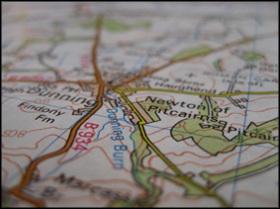 Charters found within the record can often contain significantly detailed information on a local area, placing farms, houses and other minor settlements into the surrounding physical landscape as it stood at that point in time. Note, for example, the ratification outlining the boundaries of certain lands found within the burgh of Inverness, which plots the flow and direction of rivers and burns and the placement of wells, march stones and other defining geographical features found locally [1661/1/181]. Or the ratification recording a perambulation of lands within the parish of Aberlemno in Forfar, giving a verbal description of the respective boundaries and physical markers – from standing stones, gates and dykes – found along them [1672/6/134]. While these geographical landmarks may no longer be recognisable today, and indeed some of the places long vanished, such records provide a unique historical snapshot of an area and its physical setting.
Charters found within the record can often contain significantly detailed information on a local area, placing farms, houses and other minor settlements into the surrounding physical landscape as it stood at that point in time. Note, for example, the ratification outlining the boundaries of certain lands found within the burgh of Inverness, which plots the flow and direction of rivers and burns and the placement of wells, march stones and other defining geographical features found locally [1661/1/181]. Or the ratification recording a perambulation of lands within the parish of Aberlemno in Forfar, giving a verbal description of the respective boundaries and physical markers – from standing stones, gates and dykes – found along them [1672/6/134]. While these geographical landmarks may no longer be recognisable today, and indeed some of the places long vanished, such records provide a unique historical snapshot of an area and its physical setting.
The record also contains important information on natural events that have physically changed the landscape. The fate of the barony of Culbin, near Nairn, for example, is recorded within the parliamentary acts, it being the scene of a great sandstorm in 1694 that overwhelmed the houses and lands, leaving the majority of the estate an infertile and uninhabitable desert [1695/5/225]. Although parliament issued an act to prohibit the harvesting of sea grasses for thatching [1695/5/189], a practice which had led to instability of the sand-dunes, the onslaught of sand could not be halted, leading to a further appeal by the estate’s proprietor a few years later [1698/7/60]. It was not until the twentieth century that the shifting sands were stabilised by the mass planting of trees, but the sand dunes remain a significant local feature and attraction.
The building of local landmarks, such as harbours, bridges, mills and rights of way, can also be traced within the record. Take, for example, the lengthy saga over the erection of the oldest surviving crossing on the River Clyde, Clydesholm Bridge at Lanark. First mooted in 1649 as a replacement for the erratic ferry service which operated at this perilous stretch of the river [1649/1/397], the intervention of civil war meant that the project was put on hold until 1694 [1696/9/187]. Work was eventually completed on a three-bow stone crossing in 1699. A further act in 1703 [1703/5/103] enabled the town to impose a toll on the bridge to fund inevitable repairs, given the violent river current at this point. Until it was bypassed in the 1950s, the bridge remained in constant use and largely unchanged from the original structure. It still stands today as a footbridge across the Clyde.
The history of many treasured buildings still in regular use by local communities, such as parish churches, can also uncovered. The circumstances surrounding the erection of Elie parish kirk in Fife, for instance, are detailed in an act of 1641 [1641/8/320], which also gives details on the minister’s manse and stipend and on the timings of ceremonies of worship. Its later decline into almost ruin is also recounted in parliament’s records [1670/7/23; A1672/6/24]. The very foundations of whole settlements and towns may also be detailed, such as Fraserburgh, which appears initially in the record under its original name of Faithlie. The town’s development into a flourishing fishing port with harbour, prison and market, and an abortive plan to found a university there, can all be traced through various parliamentary acts [1579/10/69; 1597/11/59].
5. What other issues did parliament deal with that I can investigate further?
The majority of parliament’s business was concerned with everyday issues that will be familiar to us all. Indeed, Scotland’s parliamentarians today deal with many similar issues that faced their historical counterparts. There are limitless themes and concepts that could be used as a basis for further study, a few examples of which are given below.
The credit crunch:
Monetary worries afflicted sixteenth-century consumers as much as their contemporaries today. Prior to the establishment of a Scottish banking system in the late seventeenth century, money was largely lent through the modern-day equivalent of loan sharks, as unscrupulous then as today. In the late sixteenth century, parliament acted to limit the interest on the lending of money to a maximum of 10% [1587/7/45], since ‘exorbitant and immoderate interest’ had been ‘the cause of the ruin and decay of many ancient livings within this country’ [1592/4/75]. Profiting at a rate higher than this was decreed to be an actual sin ‘not tolerable in a reformed and Christian commonwealth’ [A1597/5/7], yet the frequent reissuing of such acts suggest that the law had little practical effect.
Transport and infrastructure:
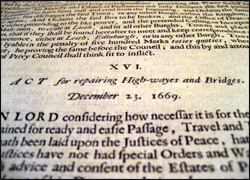
Act of 1669 ordering the repair of highways
and bridges
The state of the highways was a constant concern, given these were vital for trade and general travelling throughout the country. In 1669 [1669/10/53] the repair of the country’s roads was contracted out to parishioners themselves, who were to meet after church on Sunday suitably equipped with picks and shovels. Each parishioner was to work on the roads no more than six days per year, always outwith sowing and harvest time when manual labour was at a premium.
A further hazard for unwary travellers was the issue of subsidence near main roads where coal and other raw materials had been excavated. A special act issued in 1698 [A1698/7/5] ordered all landowners to either fill in such pits or build a 1.5 metre wall around ‘to secure the said holes from the hazard of either body or beast falling into them’.
The issue of tolls over the rivers Forth and Tay was controversial, although it was rates for ferries rather than bridges that parliament investigated. Profiteering on these key routes was a problem even in the fifteenth century. An act of James III [A1474/5/17] decreed that the individual personal fare could be no more than two pennies Scots. The transport of animals was set at six pennies. For anyone accompanying an animal, the person and any cargo they carried was to go free.
A later act of Mary Queen of Scots [A1552/2/14] stated that the excessive tolls imposed by the ferrymen of Queensferry, Kinghorn and Dundee were a ‘great and heavy oppression’ on the country. Tolls were therefore to be reduced to a maximum of 12 pennies Scots for each man and accompanying horse (£0.88 in today’s money), and six pennies (£0.44 in today’s money) for each individual traveller.
Education:
The first education was act passed in 1496 [A1496/6/4], which allowed the sons of wealthy landowners to be educated from the age of eight. The quality of teachers was addressed in 1567, with each to be assessed for competence by the kirk [A1567/12/10]. In the seventeenth century, parliament legislated for the founding of a school in every parish [1633/6/20], with parishioners supplying the cost of schoolhouse and the teacher’s salary. A primitive kind of PTA/school board was to be set up to ensure this was done [1645/11/185].
Crime and justice:
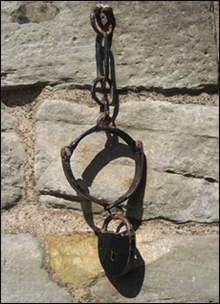
A set of 'jougs' attached to Abernethy
Round Tower, Perthshire
Parliament had important judicial functions, especially before the court of session was founded in 1532. The gathered estates could pronounce judgement on the most minor cases of theft right up to treason, for which it had particular responsibility. Corporal punishment was often favoured, even for seemingly trifling transgressions. Blasphemers, for example, could face a spell in the stocks or the ‘jougs’, a hinged collar attached to the neck and chained to a post, often situated within a busy public thoroughfare for maximum humiliation. The wearing of sackcloth was also ordered as a public display of penitence for those who transgressed strict church laws [1695/5/117]. Beggars especially could face particularly harsh punishment if they were found wandering unlawfully from parish to parish. The penalty for those apprehended included that their ‘ears be nailed to the tron or to another tree and their ears cut off and banished from the country’, or, alternatively, ‘to be scourged and burnt through the gristle of the right ear with a hot iron of the compass of an inch about’ [A1575/3/5].
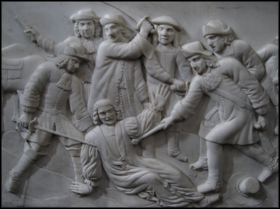
Detail from Archbishop James Sharp's tomb,
Holy Trinity Parish Church, St Andrews
Thumbscrews and the ‘boots’ (a kind of rack for the legs) were often favoured to extract confessions from parties under parliamentary trial [see, for example, 1597/11/8], although, after 1689, torture was only allowed under warrant [1689/3/108]. Before this date, however, torture was used in a number of high-profile cases, such as that of James Mitchell, would-be assassin of James Sharp, archbishop of St Andrews, who in 1668 made an ineffectual attempt to shoot the clergyman as he travelled in his coach through the centre of Edinburgh. Captured and brought to trial some years after the crime, Mitchell endured first imprisonment on the Bass Rock, then a spell in the boots, in an attempt to extract an admission of guilt. He was eventually sentenced to death in January 1678 for his role in the plot, becoming a Presbyterian martyr in the process. Archbishop Sharp himself fell victim to a more successful assassination attempt a little over a year later. In May 1679, en-route to St Andrews, at a spot on the remote Magus Muir above the town, he was dragged from his carriage by a band of Covenanters and hacked to death in front of his daughter, prompting a parliamentary act outlawing assassination as a treasonable offence [1681/7/39].
Health and medicine:
Disease was often rampant in Scotland’s major towns. Plague was the most feared, and parliament itself was forced in 1645 to decant to St Andrews because of an outbreak in its traditional home of Edinburgh. Bo’ness was effectively locked down in 1645 because of the danger of the disease spreading outwith its bounds, and any infected person who attempted to leave was ordered to be shot and killed [1645/1/22].
Basic environmental health legislation was passed by parliament in order to stop the spread of disease. Edinburgh was described as ‘a puddle of filth and filthiness’ in 1621 due to candle-makers openly burning their tallow and ‘corrupting the air’, and by butchers disposing of their refuse into the public highway whereby ‘the closes and streets are so filled therewith as there can be no passage had through the same’. Thus these professions were ordered by parliament to relocate to remoter parts of town away from the general population [1621/6/41].
The medical profession was largely unregulated until the seventeenth century. However, the surgeons of Edinburgh were granted an act in 1641 which stated that surgeons practicing within the burgh must show sufficient proof of their qualifications, so the treatment of medical conditions was ‘not left to the arbitrament and imposture of women and ignoramuses’ [1641/8/360]. The Royal College of Physicians of Edinburgh was founded in 1681 (ratified in parliament in 1685) in an attempt to put an end to the ‘certain illiterate poisoners with a criminal reputation’ who ‘have been bold enough to practise, call themselves 'doctor of medicine', and peddle prescriptions for even the most serious illnesses, at extortionate cost to the king's subjects and to the great scandal of the medical profession’ [1685/4/98]. Basic health care, however, remained out of reach for the majority of Scotland’s population.
Sustainable development:
Concern over the depletion of natural resources is not an issue exclusive to the twenty-first century. An act passed by parliament in the reign of Mary Queen of Scots, for example, records a ‘most exorbitant dearth and scantness of fuel’ within Scotland, a situation that had come about because significant amounts of coal was commonly used in empty ships for ballast. The act outlawed any export of coal beyond that to be used for fire in the ship’s voyage, under the pain of confiscation of the ship [A1563/6/22]. It seems to have been ineffectual, however, as in 1609 James VI reissued the earlier act passed in his mother’s reign, stating that through excessive exports coal had risen to ‘an extraordinary dearth and price and by all appearance the whole coal within this kingdom shall in a very short time be wanted and consumed, to the great hurt and prejudice of the whole estate’ [A1609/1/8].
Parliament was also concerned with ensuring that Scotland’s own natural resources were fully exploited. For instance, in the reign of James VI an act notes ‘the evident appearance of harm to the whole lieges of this realm if coal, which is our best fuel, be lacking or be utterly exhausted within this kingdom’. A commission was therefore chosen to inspect the condition of all coal-workings within two miles of the River Forth, to identify those in danger of flooding or collapse, and then to take steps to make sure the pits were properly worked. As the act noted, if the domestic supply could be ensured, restrictions on exports would no longer be necessary [1621/6/48].
Being green:
![Anent the harrying of hawks' nests act [1621/6/44]](images/hawksact.jpg)
Act of 1621 anent the harrying of hawks'
nests and hunting in snow
Environmental concerns were frequently addressed by parliament, even if the impetus behind such acts was preserving species for hunting and as food supplies. For instance, many acts were made forbidding destruction of habitats [1535/20; 1579/10/37; 1607/3/17], including burning of moorland, sawing down of young trees and cropping of broom. Legislation was also passed against the poaching of rabbits, bees and their hives, pigeons and fish from others’ land.
Game conservation was also a prominent issue. An act of Mary Queen of Scots [A1551/5/3] stated that since ‘the noble men of the realm can get no pastime of hawking and hunting … by reason that all wild beasts and wild fowl are exiled and banished’, the hunting of game by firearm was to be outlawed. In the reign of William II a seven-year embargo on the hunting of partridges, quail and other moorland birds was instituted in a bid to increase dwindling stocks [1698/7/159].
The planting of trees and preservation of existing ones was protected by legislation [1698/7/160; 1535/16; 1661/1/348], to provide habitat for game and wildfowl and also as timber plantations for shipping and building. It was, however, obligatory for parishioners to hunt wolves and destroy any of their whelps. Payment was made for delivery of each head to the local sheriff [1428/3/6; 1458/3/36].
Sports and pastimes:
Sport and similar activities were strictly controlled by the government, since it was thought that these were distractions from everyday work. Football and golf were famously outlawed in the fifteenth century in order that men of fighting-age instead practiced useful skills such as archery, vital if England were to invade [1471/5/6]. Later, there were restrictions placed on horse-racing and gambling with cards and dice [1621/6/26], because ‘honest men ought not expect that any winning had at any of the games can do them good or prosper’. Excessive winnings above 100 merks (the equivalent of £5.50, roughly £880 in today’s money) were to be donated to the poor of the parish.
Excessive drinkers and ‘haunters of taverns’ [1617/5/34; 1644/6/209] were legislated against by a series of acts, especially those found in public houses after 10 pm, who were to be subject to corporal punishment or imprisonment.
Gender equality:
Women were not permitted to stand or vote in parliamentary elections and their very presence in the chamber (as when the wife and daughter of the future James VII viewed proceedings in 1681) could cause great perturbation [A1681/7/1].
Parliament was, however, interested in legislating on behalf of women, especially to curb what was regarded as loose morals or sinful behaviour. Acts were passed to ensure that prostitutes were banished to the outskirts of towns [1427/3/10] and articles were later considered which proposed a law ‘that no women wear above their estate except whores’. A note in the margin inserted by the male clerk simply declares: ‘this is a good act’ [1567/12/53]. The victims of the major witch hunts of the seventeenth century, often instituted by parliament, were mainly women. Statues were also passed punishing adulterers [1592/4/29] and parliament issued a remarkable act on incest, complete with explanatory table setting out unlawful degrees of consanguinity [1649/5/219]. In addition, the infanticide act of 1690 delivered perhaps the harshest legislation of its kind in Europe, reflecting contemporary male attitudes to women as much as a desire to protect infants from murder [1690/4/111].
Dictating fashion: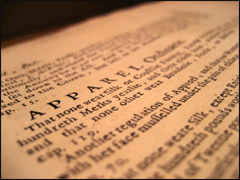
At first sight dress hardly seems like a priority for parliament, but it was not just a matter of free choice as much as a mark of social rank and status. Parliament felt it necessary to legislate for national standards of dress for particular classes of society. Sumptuary laws controlled the market in clothes and also, for example, in furs, silk, and fine trimmings of gold, silver and pearl. James I’s parliament of 1430 was the first to rule on a national dress code for lords, clergy, burgesses and commoners, outlawing the wearing of fur except for the highest classes. One of the acts explicitly stated that ‘all gentlemen's wives are not to be arrayed exceeding the estate of their husbands’ [1430/12-14]. The legislation seemingly had little effect, as a similar statute of 1581 stated that ‘the mean estate’ continued to ‘copy his highness and his nobility in the use and wearing of costly clothing’, in contrary to the laws already passed [1581/10/37].
Parliamentary expenses:
Parliamentary representatives prior to 1707 were, like their equivalent today, entitled to claim expenses for any outlay incurred whilst attending a session. An act of 1428 [1428/3/3] ordered commissioners’ expenses to be paid by the shires that sent them. This was ratified in both the 1567 [1567/12/45] and 1587 acts [1587/7/143] concerning shire representation, although no sum was explicitly mentioned.
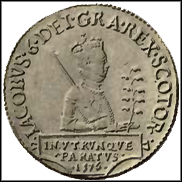
Coin depicting James VI as a
boy king, dated 1576
The cost of ceremonial dress (specifically foot-mantles of velvet, a kind of long cloak worn whilst mounted on horseback) for the riding of parliament procession was also to be met by constituents. In 1633, after complaints that constituents weren’t paying up because they were unsure of a reasonable amount, the Scottish privy council (RPCS, series 2, v, 66-7) ordered that for the forthcoming parliament each commissioner should have a lump sum of 300 merks (the equivalent of £16.67 sterling, roughly £2,170 in today’s money) for general expenses. This was in addition to the price of a foot-mantle, which, in a cost-cutting move, was to remain the property of the shire rather than the elected individual and passed on to succeeding commissioners.
A later act of 1641 modified the allowance for expenses to £5 Scots per day (the equivalent of £0.42 sterling, roughly £53 in today’s money) during the sitting of parliament, and the same daily amount for their journey to and from parliament. The permitted travelling allowance ranged from one day for commissioners from Mid-Lothian, up to sixteen days for those travelling from Caithness and up to thirty days for those coming from Orkney. The daily payment of expenses ensured that commissioners attended regularly. To prove that each commissioner had been present, at the end of each parliament the clerk register was to issue certificates of attendance to enable expense claims to be made [1690/9/15].
This was a relatively generous allowance. To place the sums involved in context, when parliament met in St Andrews in November 1645 due to an outbreak of plague in Edinburgh, in response to local hoteliers promptly upping the prices, daily bed and breakfast rates were set at a meagre six shillings Scots for the commissioner himself (the equivalent of £0.02 sterling, now worth £3.20), four shillings for any servants (the equivalent of just over £0.01 sterling, now worth £2.14) and six shillings for provision of fire and candles (the equivalent of £0.02 sterling, now worth £3.20) [1645/11/289], thus leaving a significant sum left over from their daily allowance.
After the Restoration of the monarchy in 1660, as seats in parliament increasingly became an object of ambition, opinion shifted towards the principle that commissioners should meet their own expenses. Some prospective candidates secured election on the promise that they would not exercise their right to claim fees from constituents [1681/7/63]. It was agreed in 1707 that the articles of union should not include a clause with reference to payment of members [1706/10/285], indicating that the practice of claiming expenses had fallen into desuetude, if indeed it had ever been widely followed.
Parliamentary standards:
Debates in parliament could often become heated, as opposing parties engaged in arguments and squabbles that would be familiar to today’s MSPs. In response to what was thought to be a decline in standards, parliament passed a series of acts setting out appropriate behaviour. One article decreed that the only weapons allowed within the chamber were to be members’ swords. To curb verbal personal attacks, and for ‘eschewing of contest and hate’, speakers were ordered to direct their comments to the president of parliament or lord chancellor (equivalent to today’s Presiding Officer or Speaker) rather than individual members [A1641/7/6].
A constant problem for parliament was enforcing attendance at its meetings. By the later seventeenth century some sessions could go on for six months at a time, much of it made up of private business, perhaps of little relevance to some commissioners. Meetings of parliament were also places where much other business was done, as Scotland’s most powerful men all flocked to the one place. The temptation to skip a day’s session to instead frequent a local inn or coffee-house must have been great! Some localities never even sent members, pleading distance, a lack of individuals suitable for election and an inability to pay a commissioner’s expenses. Thus, in an attempt to improve attendance, parliament fined its members a daily rate for lateness and also for absence (£20 Scots (£1.67 sterling) for each nobleman, roughly £210 in today’s money), although it’s doubtful such legislation had the desired effect.
A dress code for parliament was established and enforced. In 1455 fines were introduced for inappropriate attire [1455/8/12]. In 1587 these penalties were raised to £200 Scots (the equivalent of £33 sterling, roughly £6,000 in today’s money), with the offending party also being excluded from the chamber [1587/7/26].
Daily parliamentary sessions were set up in the 1640s. The chamber was to sit from 9am to 12pm, then from 3pm to 6pm, except on Saturdays, when there was only a morning session, and on Mondays, when no meeting was held. The start and end times of each session was to be indicated by the ringing of a bell [all 1641/7/27].
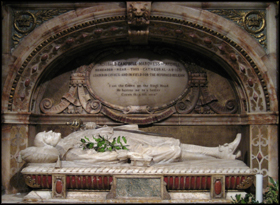
Marble tomb of Archibald Campbell, marquis of
Argyll, St Giles' Cathedral, Edinburgh
An act of 1662 added to the regulations, decreeing that no member was allowed to speak more than twice per session without special permission or to interrupt other speakers. All personal ‘reflections’ directed towards other members were explicitly outlawed [1662/5/6], although it’s clear from contemporary sources that debates remained as intense as ever, despite such rules. Indeed, tempers often became frayed in the heat of debate, and parliament was occasionally forced to investigate disputes among its own members, including instances where individuals ‘threatened’ one another [C1681/7/36]. A violent disagreement arose in 1703 between John Hamilton, lord Belhaven and Sir Alexander Ogilvie of Forglen, the member for the burgh of Banff. During a debate over a disputed election heated words passed between them and tempers flared, leading to a melee. Such was the mayhem that parliament was adjourned and both men arrested. They were forced to apologies to the house before being allowed to return to their seats, a lenient treatment as they were well connected to the families of the duke of Hamilton and the earl of Seafield [1703/5/100-101]
Despite such rules instituted to preserve a degree of decorum within the chamber, political opponents were often treated harshly by the ruling party within parliament. For instance, in 1672 William Moir, commissioner for the burgh of Kintore, was thrown into prison for speaking out of turn before the king’s commissioner and only allowed to retake his seat after appearing on his knees before the assembled estates to seek pardon [1672/6/12]. Parliament, in its capacity as highest court of law in the land, passed numerous sentences of death and forfeiture on some of the most significant figures of the day, including its own members, such as James Graham, 1st marquis of Montrose (executed May 1650) and Archibald Campbell, 1st marquis of Argyll (executed 1661). The chamber was often adjourned to allow the members to attend the public executions.
Ceremonial pomp and pageantry:
The outdoor ceremony and processioning associated with the pre-1707 parliament was a mass and ‘popular’ event. The opening and closing days of a session of parliament were distinguished by the pomp of public procession, the ‘riding’ of parliament, when the members of parliament on horseback accompanied the king or his commissioner from Holyrood to and from Parliament House. In an age before mass media this ceremonial underlined the key position of parliament in the life of the nation. The ‘riding’ was a specifically Scottish ceremony that dated back to the fifteenth century and probably existed in some form long before. Extensive preparations were made for this important procession, including clearing the Royal Mile of litter, vagrants, carriages and obstructions. Barriers were erected to hold back the viewing crowds, and banks of timber were constructed at either end of the route for the participants to mount and dismount from their horses. The route itself, lined with troops displaying arms, was liberally decorated, with banners, rugs and carpets hung from the upper windows of buildings. Large crowds gathered to watch the procession, necessitating the Privy Council to pass numerous acts of council to control the throng. However, it was ever easy to lambaste and curse the proceedings and, if necessary, to disappear down one of the many narrow closes that still radiate outward from the High Street of Edinburgh.
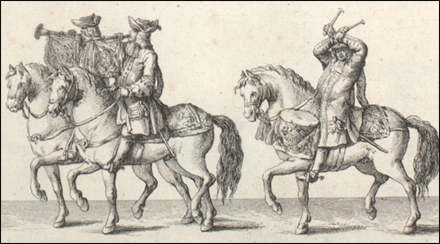
Detail from Chalmers' illustration of the Riding of Parliament in 1685
The procession itself was a cavalcade of colour. An act of 1455 [1455/8/12] dictated the strict dress code for the riding, and, depending on rank, members of parliament wore lavish brown, red or blue velvet cloaks, each lined with fur and matching hoods. Three senior members of the nobility at the back of the procession carried the ancient honours of Scotland - the crown borne on a cushion, and also the sword and sceptre. The order of procession was dictated strictly by rank, ‘the higher degree and most honourable of that degree to ride always last’ [A1703/5/1]. This ensured that all were gathered at the chamber to witness the arrival of the honours of Scotland and the monarch or, in his or her absence, a royal representative.
Before the early-seventeenth century parliament traditionally met in the old tolbooth, which stood near the north-west corner of Parliament Square in Edinburgh. But the increase in numbers called out for a purpose built venue, and in 1632 Charles I ordered the city to build a new chamber. Similar to its modern counterpart, this Parliament House (located near St Giles’ Cathedral) was over-budget and behind schedule when it held its first meeting in 1639. But the Great Hall in which the members of parliament now gathered was as impressive as today’s debating chamber: ‘a magnificent room 120 feet long, over 40 feet wide, and 40 feet high, with a very fine oak hammer-beam roof’. It still stands today as part of the buildings that make up the Scottish law courts. On entering the new building members were greeted by the statues of Justice and Mercy placed over the door to parliament hall, and these were linked by a Latin inscription: ‘These are the virtues which make kingdoms happy’.
The project team would like to thank Dr Bruce Durie, Course Director, Genealogical Studies, University of Strathclyde; Dr Chris Robinson, Director, Scottish Language Dictionaries; and Dr Simon Taylor, Department of Celtic, University of Glasgow, for their input to this webpage.